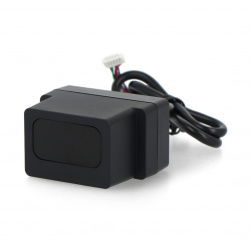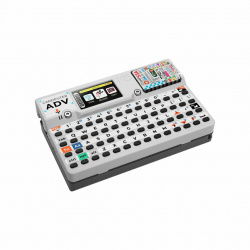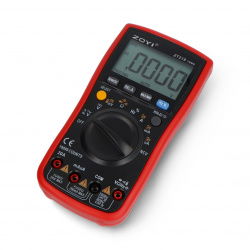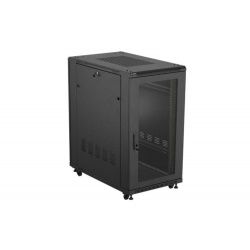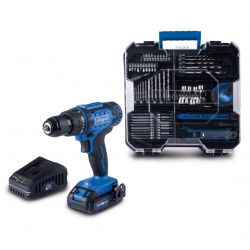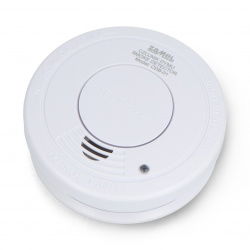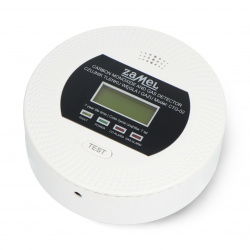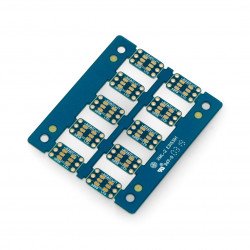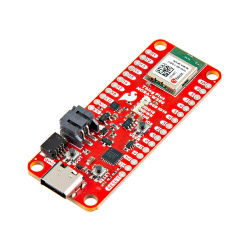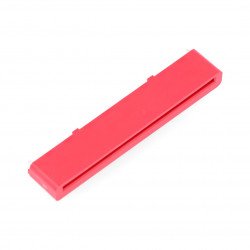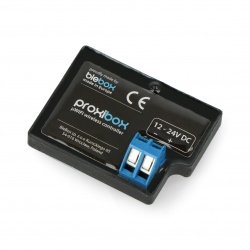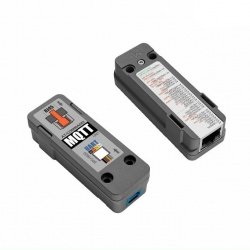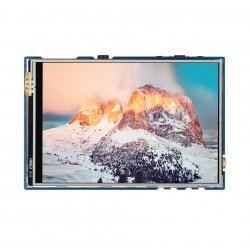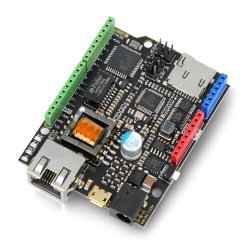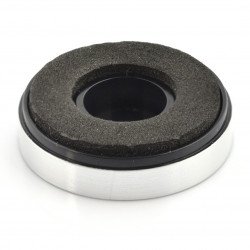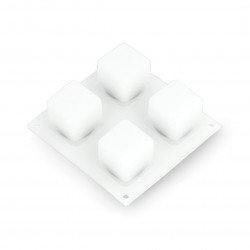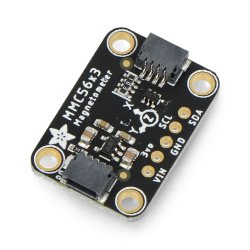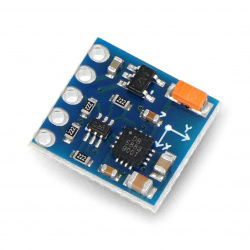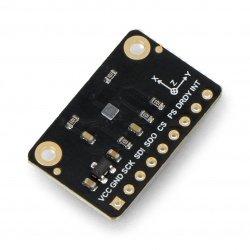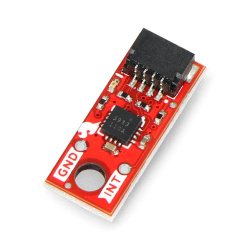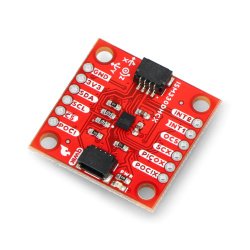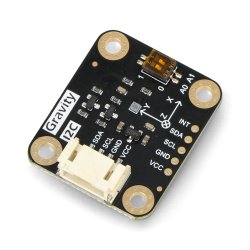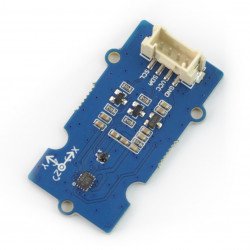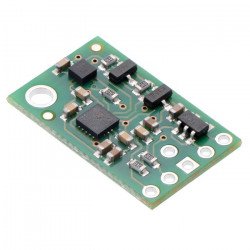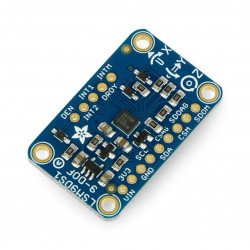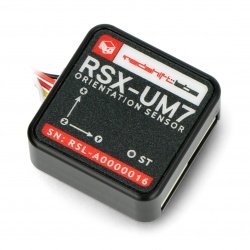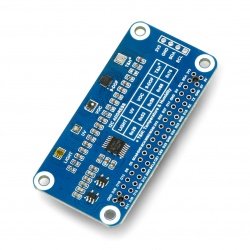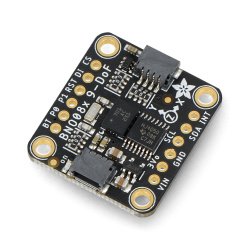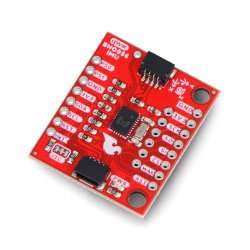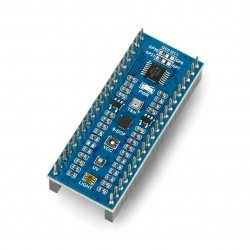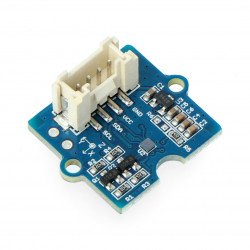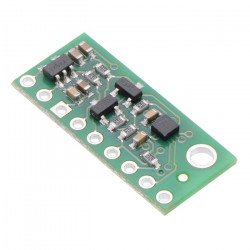Magnometer - In order to determine the coordinates and orientation of an object, sensor devices are often used. Such devices include gyroscopes, accelerometers and magnetometers. Despite having a similar application area, they each measure different quantities. By combining them into one device, you get a powerful tool to help determine the location and direction of movement of, for example, a drone or robot. Appropriately designed electronic circuitry performing these functions can be found in many variants in the Botland shop offer.
Magnetometers
3-axis magnetometer - MMC5603 - STEMMA QT / Qwiic - Adafruit 5579
The Magnetometer from Adafruit is equipped with the MMC5603 system - monolithic, integrated 3-axis AMR magnetic sensor. It is characterized by high sensitivity and has a...BMM150 3-Axis Magnetometer Sensor - I2C/SPI - Waveshare 24657
The BMM150 3-axis magnetometer from Waveshare provides accurate magnetic field measurements in three axes X, Y and Z. It is characterized by small dimensions, low power...Magnetometer GY-271 3-axis digital I2C 3,3V / 5V - QMC5883L
Sensor to measure the magnetic field in three axes in the range of ±8 gauss with a resolution of 5 miles gaus. It works with the voltage from 3.3 V to 5.0 V. It is...Fermion - 3-axis magnetometer - BMM150 - I2C/SPI - DFRobot SEN0419
Module with a three-axis magnetometer from DFRobot, equipped with a Bosch BMM150 system - based on the FlipCore technology. It enables the measurement of the magnetic field...Micro 3-axis magnetometer - MMC5983MA - Qwiic - SparkFun SEN-19921
3-axis magnetometer in miniature version, equipped with the MMC5983MA system by MEMSIC . It is characterized by high sensitivity , allowing the accuracy of the course on...SparkFun 6 DoF IMU - ISM330DHCX - 3-axis accelerometer and gyroscope - SparkFun SEN-19764
The board is equipped with the ISM330DHCX system containing a 3-axis accelerometer and a 3-axis gyroscope. The module allows you to measure linear acceleration in the range of...Gravity - 3-axis magnetometer - BMM150 - I2C - DFRobot SEN0529
DFRobot three-axis magnetometer with Bosh BMM150 system based on FlipCore technology. The module allows you to measure the magnetic field in three perpendiculars in the...Grove - 3-axis accelerometer, gyroscope and magnetometer - ICM20600 + AK09918 - I2C
The module from Grove series, designed for 9-deegre inertial navigation (IMU). It acts as a gyroscope, accelerometer and electronic compass. It allows you to measure angular...MinIMU-9 v6 - module with accelerometer and magnetometer - LSM6DSO and LIS3MDL - Pololu 2862
MinIMU-9 v6 is an measurement unit (IMU) that includes a 3-axis gyroscope , an LSM6DSO accelerometer and a LIS3MDL magnetometer. All these elements are placed on a compact...- Reduced price
- SPECIAL OFFERS
MinIMU-9 v5 9DOF - accelerometer, gyroscope and magnetometer I2C - Pololu 2738
The sensor allows to measure 9 sizes: acceleration X, Y, Z magnetic field X, Y, Z and angular velocity X, Y, Z. It is a combination of 3-axis accelerometer and gyroscope...9-DOF Accel/Mag/Gyro+Temp Breakout Board - LSM9DS1 - Adafruit 3387
The sensor is a combination of 3-axis digital gyroscope, accelerometer and compass. It allows you to measure acceleration, magnetic field and angular velocity in the...ICM-20948 9DoF - 3-axis accelerometer, gyroscope and magnetometer I2C/SPI Qwiic - Adafruit 4554
The Adafruit module is a combination of 3-axis gyroscope, accelerometer and compass. It allows to measure acceleration, magnetic field and angular velocity. The measuring...Environmental sensor - hat for Raspberry Pi - Waveshare 20471
An environmental sensor in the form of an overlay for Raspberry Pi equipped with a number of useful sensors. It has built-in temperature , humidity , air pressure, ambient...9DoF IMU Breakout - ISM330DHCX, MMC5983MA - Qwiic - SparkFun SEN-19895
SparkFun Qwiic 9DoF IMU Breakout sensor combines a high-performance digital ISM330DHCX accelerometer, a gyroscope and a highly sensitive three-axis magnetometer MMC5983MA ....BNO085 9-DOF IMU Fusion Breakout - 3-axis accelerometer, magnetometer and gyroscope - Adafruit 4754
Sensor based on the BNO085 system equipped with an accelerometer, magnetometer and gyroscope. Allows you to measure acceleration, spatial orientation, and where the strongest...VR IMU Breakout - VR module with IMU sensor - BNO086 - Qwiic - SparkFun SEN-22857
VR IMU Breakout from SparkFun is a module with an IMU sensor intended for use in the field of virtual reality (VR). It is equipped with an efficient BNO086 chip from...3-axis magnetometer - TLV493D - STEMMA QT/Qwiic - Adafruit 4366
3-axis magnetometer manufactured by Adafruit and equipped with an efficient TLV493D system. The maximum data transfer rate is up to 1 Mb/s . The module is used when...I2C Environmental Sensor - for Raspberry Pi Pico - Waveshare 20232
A module designed for the Raspberry Pi Pico equipped with a range of useful environmental sensors . Manufactured by Waveshare, it includes temperature, humidity, air...Grove - 3 Axis Digital Compass V2
Grove Series 3-axis digital compass based on the Bosch BMM150. It allows to measure magnetic field in three perpendicular axes. The data can be read out using the I2C and SPI...LIS3MDL 3-axis digital magnetometer I2C/SPI - Pololu 2737
Sensor to measure magnetic field in three axes in the range from ±4 gauss to ±16 gauss. The supply voltage is from 2.5 V to 5.5 V, sensor is characterized by small size, low...See also
- Piezoelectric sensors
- RPM sensors
- Twilight sensors
- Tilt sensors
- Accelerometers
- Inductive sensors
- Hall effect sensors
- Oxygen sensors
- Optical sensors
- Resistance sensors
- Door sensors
- Alarm sensors
- 9DoF IMU sensors
- Pressure sensors
- Air quality sensors
- Sound sensors
- Gesture sensors
- Gas sensors
- Limit switches
- Sensors of light and color
- Magnetic sensors
- Medical sensors
- Pressure sensors
- Sensors odbiciowe
- Distance sensors
- Inductive contactless sensors
- Weather sensors
- Liquid level sensors
- Current sensors
- Flow sensors
- Motion sensors
- Temperature sensors
- PT100 temperature probes
- Humidity sensors
- Fingerprint readers
- Encoders
- Photoresistors
- Phototransistors
- IR receivers
- Gyros
- Sensor sets
- Grove modules
- Gravity modules
What is a magnetometer and how does it work?
Among the MEMS sensors included in the Botland store's offer, you will find devices with a built-in gyroscope, accelerometer, and a magnetometer - a device used to measure the magnetic field intensity, most often based on the Hall effect or magnetoresistance phenomenon. The device can be used, for example, to measure the earth's magnetic field (proton magnetometer) or to detect metals. In a Hall magnetometer, if we connect a voltage source to a metal plate, we cause a current to flow between the two surfaces of the plate. In turn, the Gaussian vibration magnetometer works on the principle of vibrations of a small magnet. The name of the device comes from its inventor, CF Gauss. It was the first device to measure absolute magnetic intensity.
Magnetometer – a device for measuring the magnetic field
When we bring a source of magnetic field (e.g. a magnet) close to a plate powered by direct voltage, we distort the electron flow path on the plate surface. Then, one side of the plate will be occupied by electrons and the other by protons. In this way we will observe changes in the magnetic field.
After connecting a voltmeter with a readable display between both surfaces of the board, we will be able to read the voltage, the value of which depends on the intensity of the magnetic field and its direction of influence in space. A magnetometer is a device used to measure the magnetic field of various elements (it can be used to measure the magnetic properties of matter).
Additional information about magnetic field measurements
The magnetoresistive concept of the magnetometer uses materials that are sensitive to the magnetic field - an iron-nickel alloy is often found. Such materials change their resistance when exposed to a magnetic field, which is why magnetometers are used to measure the magnetic field.
The MEMS sensors available in our offer are also equipped with an I2C interface, thanks to which you can easily connect your magnetometer to work with, for example, Arduino or Raspberry Pi .
Magnometer in the phone - MEMS gyroscopes - small and practical
If you want to easily develop your robot design in terms of its balance stability when stopping, moving or standing still on an uneven surface. An excellent solution will be the use of a small MEMS gyroscope which, by measuring the angular deviation of the robot from the equilibrium position, will transmit information to Arduino, which, by controlling appropriate motors and servomechanisms, will set the robot in the correct position, preventing it from unintentionally tipping over. A magnetometer is used in many electronic projects.
And how is angular velocity measured by a MEMS gyroscope? The sensor built into these devices has dimensions not exceeding the diameter of a human hair and works based on the phenomenon of mechanical resonance. When the gyroscope is rotated, the MEMS sensor converts this movement into a very low voltage signal, proportional to the rotation angle. Then, this signal is amplified and transmitted to the microcontroller, where further decisions are made via the program depending on the read voltage value.
Accelerometer - easy measurement of acceleration
Accelerometers are devices whose task is to measure acceleration - a quantity that describes how quickly an object's speed changes over time. Accelerometers are helpful tools in measurement systems for detecting vibrations of the tested object and in navigation systems. The accelerometer detects the static and dynamic effects of acceleration.
Static forces include gravity, and dynamic forces include vibration and displacement. Accelerometers can measure acceleration in one, two, or three axes of a coordinate system, but as with gyroscopes, the three-axis solution is at the forefront.
Construction of an accelerometer
The structure of a typical accelerometer includes microscopic electrodes forming a capacitor suspended on springs. Under the influence of acceleration, the electrodes move relative to each other, changing the capacitance between them - the speed of these changes makes it possible to determine the acceleration of the object on which the accelerometer works.
There are also piezoelectric accelerometers in which a suitable material, under the influence of mechanical influence, generates an electric charge on its surface - this phenomenon is used, among others, when performing seismic measurements.
Magnometers - FAQ
The magnetometer belongs to the group of MEMS sensors. It is used to precisely measure the magnetic field, or more precisely, its intensity. Some magnetometers operate on the principle of the Hall effect, while others use the phenomenon of magnetoresistance. Magnetometers have various applications. They can be used, among others: for detecting metals or for measuring magnetic fields, e.g. earth. A specific type of sensor is a Gaussian magnetometer, which uses the vibrations of a very small magnet.
When choosing a magnetometer , you should first of all take into account the measurement range, type of communication interfaces, FSR, measurement resolution, accuracy and supply voltage range and additional sensors. Other important parameters are measurement accuracy, e.g. ±0.5° and total RMS noise. Selected magnetometer models are mounted on a printed circuit board equipped with Qwiic connectors.






























































































































































































































































































































